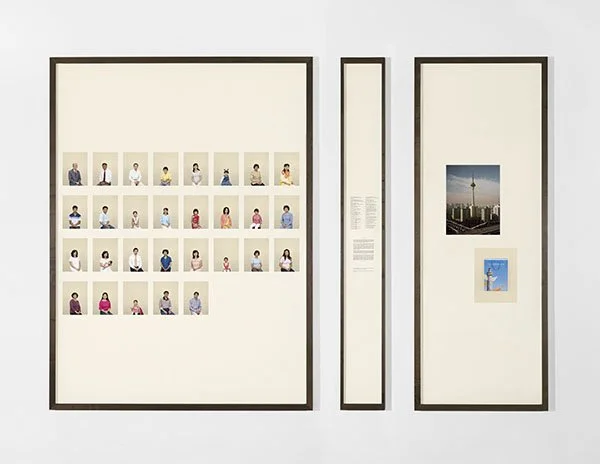Installation View Why Socialism? by Albert Einstein curated by Gabriel Orozco, kurimanzutto New York, 2025. Photo: Zach Hyman.
text by Poppy Baring
Albert Einstein’s 1949 essay, “Why Socialism?” is as relevant now as it was almost seventy-five years ago. Featuring numerous artists’ responses to the essay, artist and curator Gabriel Orozco opens the show with a refined version of the text, presented as a collage of modest photocopies. Themes that are still eerily close to those that swell in today’s discourse are included, such as “private capital tends to be concentrated in few hands,” “legislative bodies are selected by political parties largely financed by private capitalists,” “production is carried on for profit not for use,” and “an exaggerated competitive attitude is inculcated into the student who is trained to worship acquisitive success.”
Installation View Why Socialism? by Albert Einstein curated by Gabriel Orozco, kurimanzutto New York, 2025. Photo: Zach Hyman
These brief summaries of Albert Einstein’s contestations of capitalism are still echoed in media today. In a recent interview with comedian Marc Maron, Barack Obama spoke about how our culture is geared toward consumption, material goods, and fame. The author Scott Galloways, when speaking with Piers Morgan, notes that innovation has somehow excused depravity, citing Elon Musk as a clear example. Geoffrey Hinton, one of the pioneers of modern AI and winner of the 2024 Nobel prize, warned audiences of the danger of digital beings created by companies motivated by short-term profits. The answer to these issues suggested by Einstein in “Why Socialism?” is a socialist economy and an educational system orientated towards social goals.
Installation View Why Socialism? by Albert Einstein curated by Gabriel Orozco, kurimanzutto New York, 2025. Photo: Zach Hyman.
While visitors are left with political thoughts ruminating, they enter the almost all black-and-white main room of the exhibition and approach large grayscale flags of United Nations members, made by Wilfredo Prieto in a piece called “Apolitico.” Their loss of color strips away any signs of allegiance or patriotism and presents these flags as interchangeable. Other works, such as Ariel Schlesinger’s “Burnt Newspapers,” show the fragility of historical records, which is brought up again in the final and most shocking part of the exhibition, “The Pegasus Stories” by Forensic Architecture.
This video on digital violence reveals the terrifying real-life experiences of international human rights defenders, journalists, lawyers, and activists whose devices were infected and monitored by corporations using Pegasus, a destructive software developed by the Israeli cyber-weapons manufacturer NSO Group. Initially developed as just one part of Israel’s mass surveillance of Palestinians, Pegasus is now being used to target individuals across forty-five countries. In the passage for visitors to read before watching the film, they explain the American government’s public rejections of the software, as contrasted with its private acquisition of some of its tools from the NSO group’s U.S affiliate, epitomizing American hypocrisy and depravity at its finest.
This exhibition exposes visitors to an array of artists’ responses to Einstein’s essay. The stories reported in the final film are enough to leave you speechless, and overall, this display provides a dark and scary reflection of our current reality, which indeed supplies an answer to the question being posed.
Installation View Why Socialism? by Albert Einstein curated by Gabriel Orozco, kurimanzutto New York, 2025. Photo: Zach Hyman.
Featured artists include Ariel Schlesinger, Forensic Architecture, Minerva Cuevas, Petrit Halilaj, Robert Longo, Roman Ondak, Wilfredo Prieto, Zoe Leonard, and special guests.
Why Socialism? By Albert Einstein is on view through October 18 at Kurimanzutto 516 W 20th St, New York





